“I know my corn plants intimately, and I find it a great pleasure to know them.
”
Pellagra. If your diet lacks niacin (vitamin B3), you may fall victim to this malnutrition disease. The symptoms include diarrhea, skin lesions, mental confusion, nerve damage, aggression, heart damage, and eventually dementia. Corn has plenty of niacin. The problem is that it is not bioavailable. A diet based on corn can be deadly, without the culinary tradition that evolved with this crop. In addition to the whole pellagra issue, certain corn loving molds produce mycotoxins. These are carcinogenic and have other, more acute, detrimental properties. Corn born mycotoxins killed 125 people in Kenya, in 2004. Corn related epidemics were common in cultures that adopted its cultivation in the 1500's. Europeans and North Africans were quick to adopt this high yielding crop from the new world. Unfortunately, the reductionist arrogance of sixteenth century Europe dismissed the traditional preparation of this food in favor of a mechanized process to separate the skin from the kernels. Columbus, no doubt, witnessed people cooking corn in ash water and snickered. Clearly, he wasn't a chef. If he was, the aroma alone of lye cooked corn would have driven him to understand the technique.
The nixtamalization of corn is tribal chemistry at its finest. Etymologically, nixtamal is "ash dough". The idea is that by cooking dried dent corn in an alkaline solution, you turn it from toxic cardboard into food. I have no knowledge of the origin story of nixtamal, but I'm sure there are oral accounts of how it was incorporated into the culture of pre-Columbian Central and South America. Wood ash and field corn aren't exactly chocolate and peanut butter, after all. However it came to be, it is amazing. By boiling corn in lye water, made from ashes, the niacin is converted into a bioavailable form. Fungi and mycotoxins are destroyed. Glycerides are produced that allow dough to be formed. Amino acids are unlocked that form complete proteins when eaten with beans. Tough corn kernels can be freed from their skins with running water, and then easily ground into masa. This masa need only be lightly kneaded, pressed, and cooked on a hot rock to form tortillas. Spit roast a pig, boil up some beans, and that, boys and girls, is how Mexico happened.
Wood ash, as a cooking ingredient, is also fascinating. There are trace minerals in the bodies of trees that are hard to incorporate into the diet. Drinking ash tea is even worse for health than pellagara. Think drain-o. Nixtamalization transfers copper and other minerals from the tree to the corn. Brilliant! Dump your ash solution into a grease pot, and you make soap. Super handy, that soap.
In modern cooking, we have masa harina. This is nixtamalized corn that is ground and dried. It's not as handy as soap, but still pretty handy. It's not made with wood ash, either. If you want to go half way, you can nixtamalize corn with lime, like the masa harina makers do. All of the corn chips and corn tortillas you buy are made this way. Most are "round up ready" (glyphosate marinated) GMO corn. "Lime", also known as "cal" is calcium hydroxide. Also used in plasters and as a soil amendment, lime is slaked (water processed) lime stone. It works, is easily measured, and does most of what to original process does. It's not as nutritious, and it doesn't taste as good, however.
Four years ago, we held a gathering at our ranch in the mountains. One of the guests was a man I'd only met in passing. When he arrived, he gave me a gift. It was a cob of beautiful emerald colored corn. Each kernel had a dent, in the crown, and the cob was thick, and stout. He told me, "it's oaxacan green corn". The next spring, I planted it. Taking the advice of one of my farming brothers, I waited for the first legit thunderstorm of the new season. I shucked the corn into a bowl, rolled tobacco in a corn husk and knelt in the rain and prayed with that smoke as the water fell on the gleaming kernels. I planted them with thoughts of the people they would feed. I thought of the man who shared the seed. I thought of the soil life that would dance among its roots, and the birds that would rest on its high stalks. It grew beautifully. One cob became gallons of corn. As soon as I hear those sky buffalo rumbling in the clouds this spring, I will plant it again, for the fourth time. The man who brought that seed to me now is a founding principal in Lineage Seeds. His name is Jared Hāgood. They are doing great things for seed saving and seed culture. Go buy their stuff.
Having all this corn now (and other old, genetically unmolested varieties) I set out to refine a system of processing it into food that befit its beauty. What follows is that approach. I take it all the way to finished tamales, but once the corn is rinsed, it can be simmered with pork and chili to make posole, or ground for tortillas. This is also a great way to incorporate more lard into your diet. And yes, that's a good thing! Like most of the highly inconvenient recipes on this site, this one takes days and has a ton of steps, but the effort will redefine your understanding of this delicious, yet portable, classic.
First, we preform nixtamalization!
Ingredients:
2 cups dry corn
2 cups sifted wood ash
1/2 gallon water (rain water is best, distilled is good, too. I use the water from my well.)
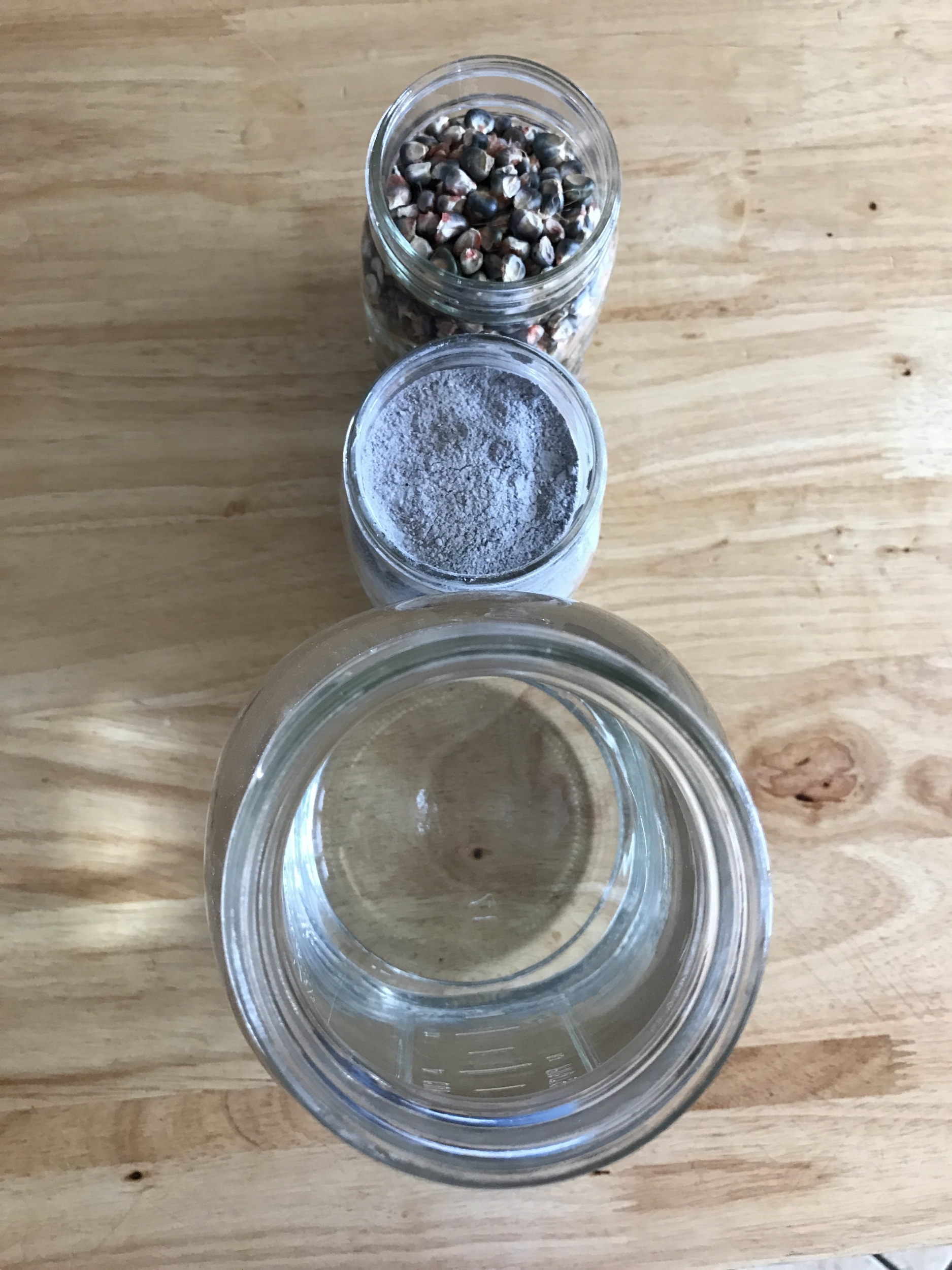
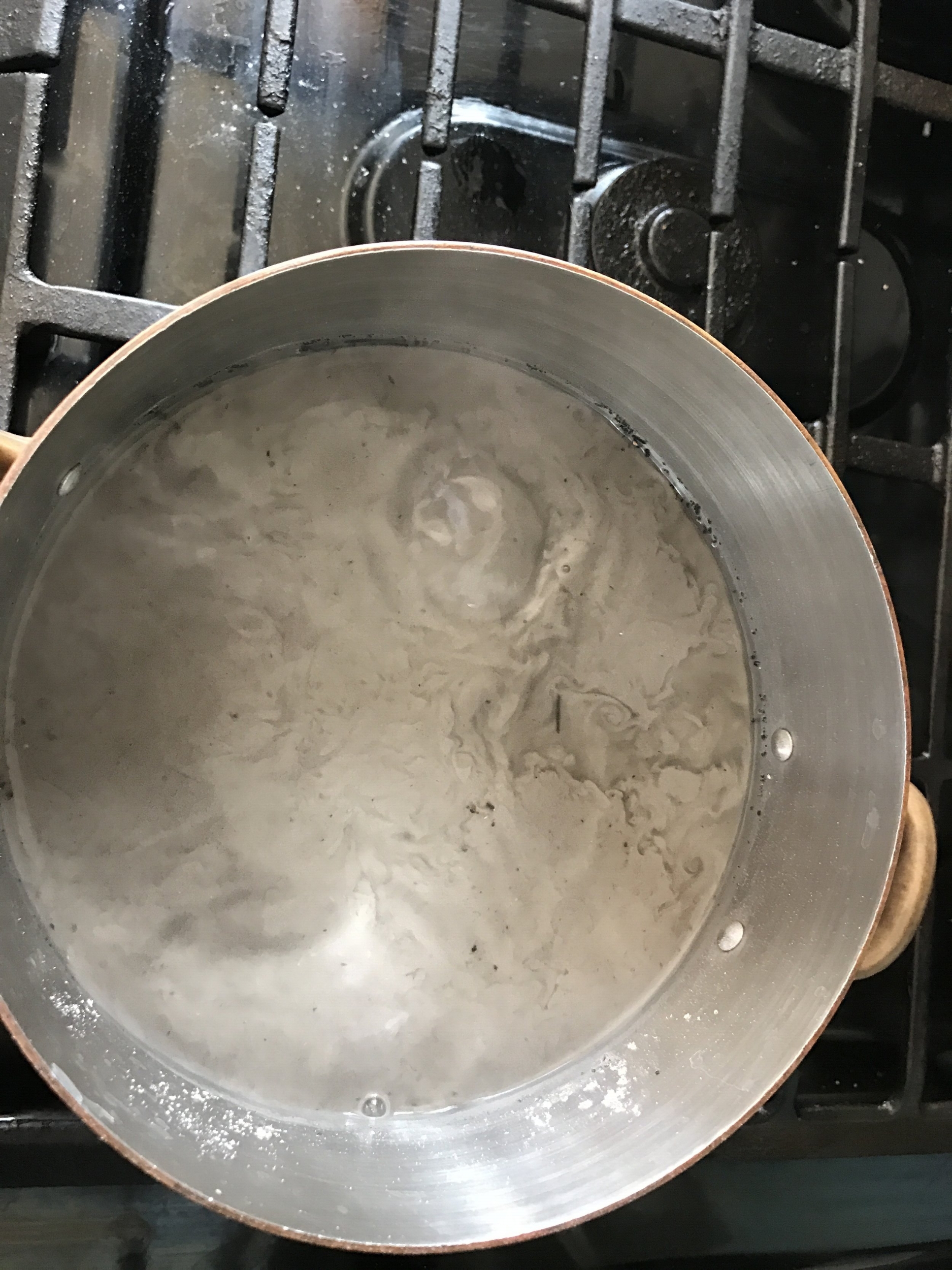
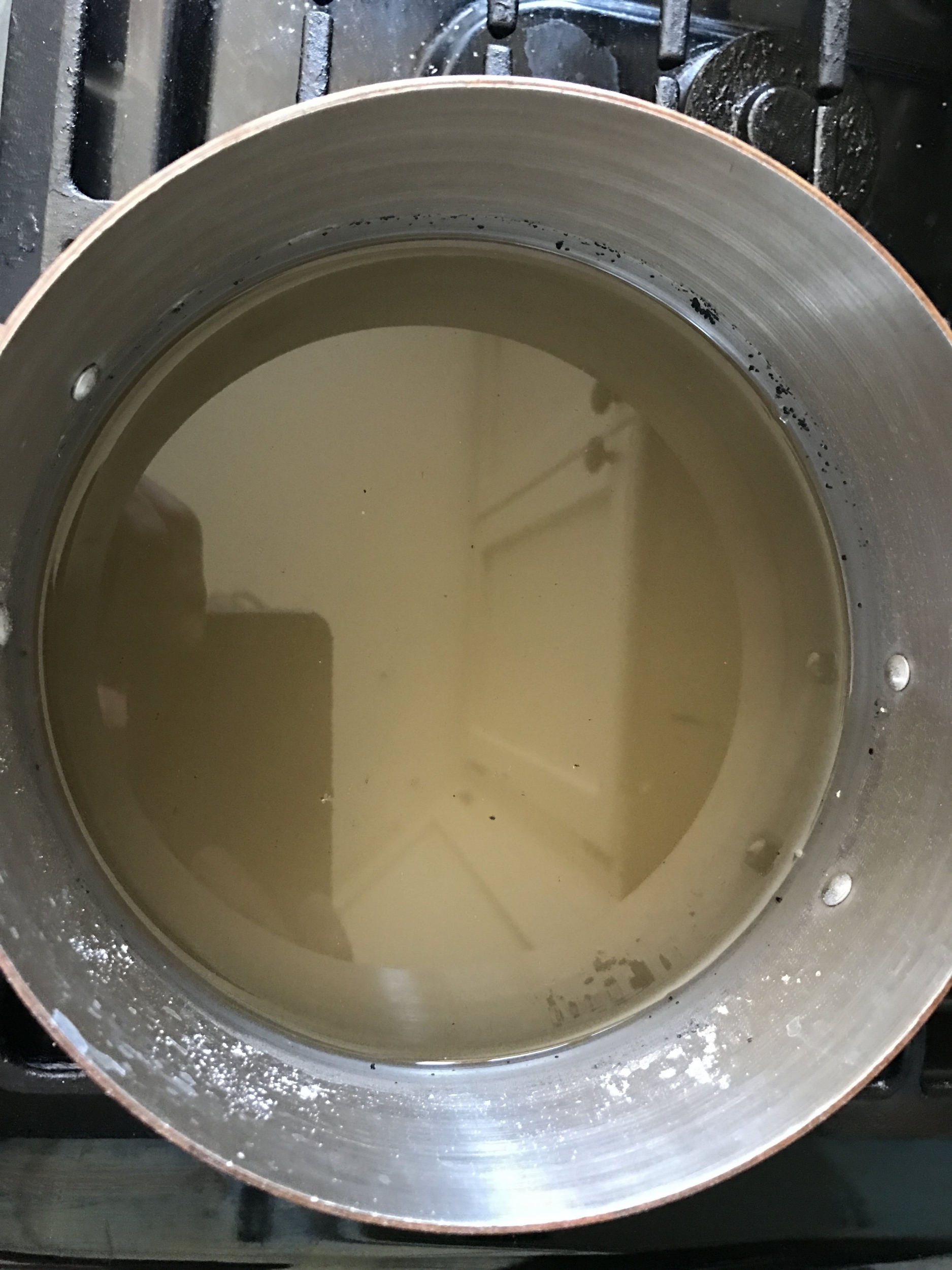
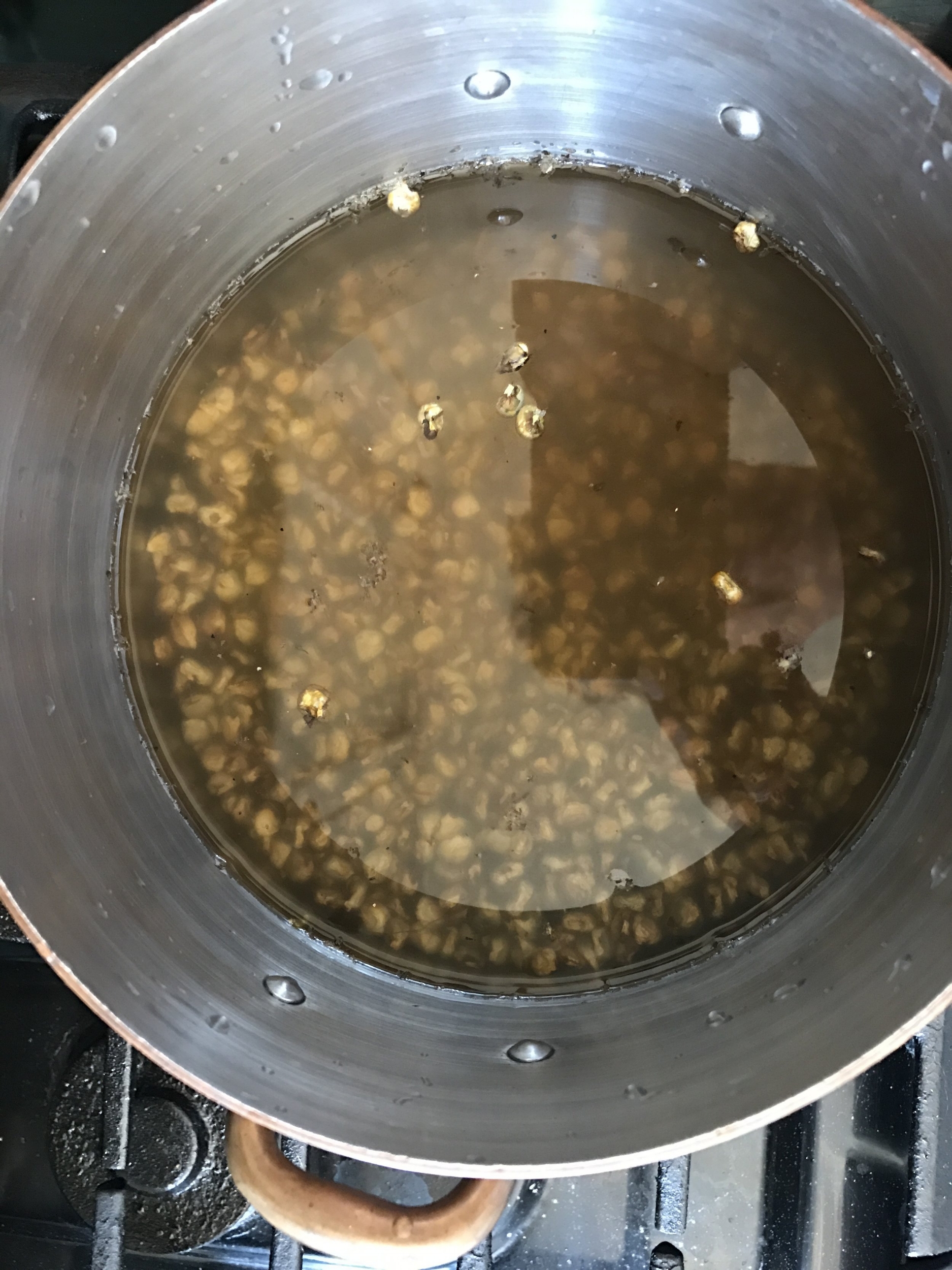
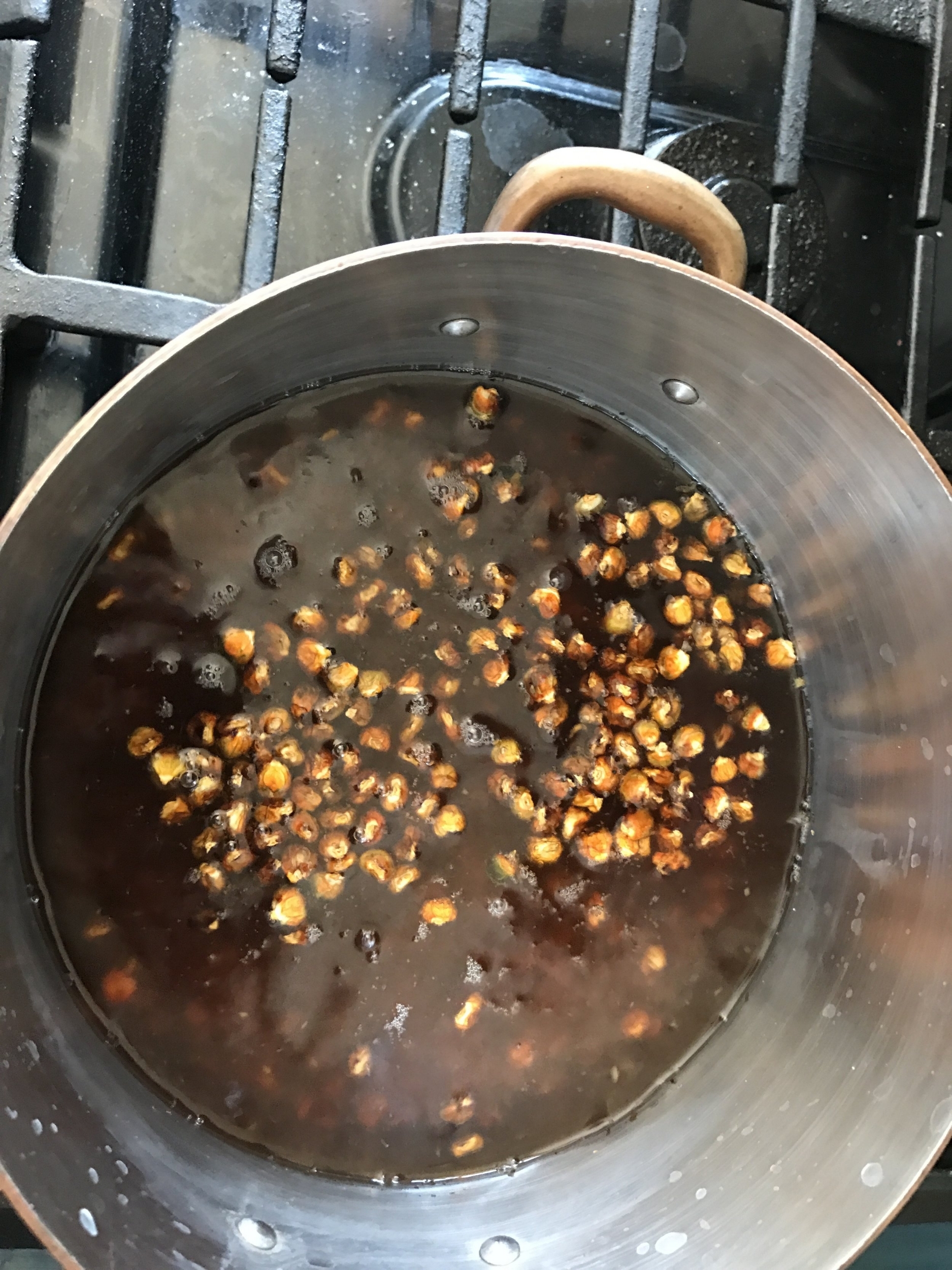

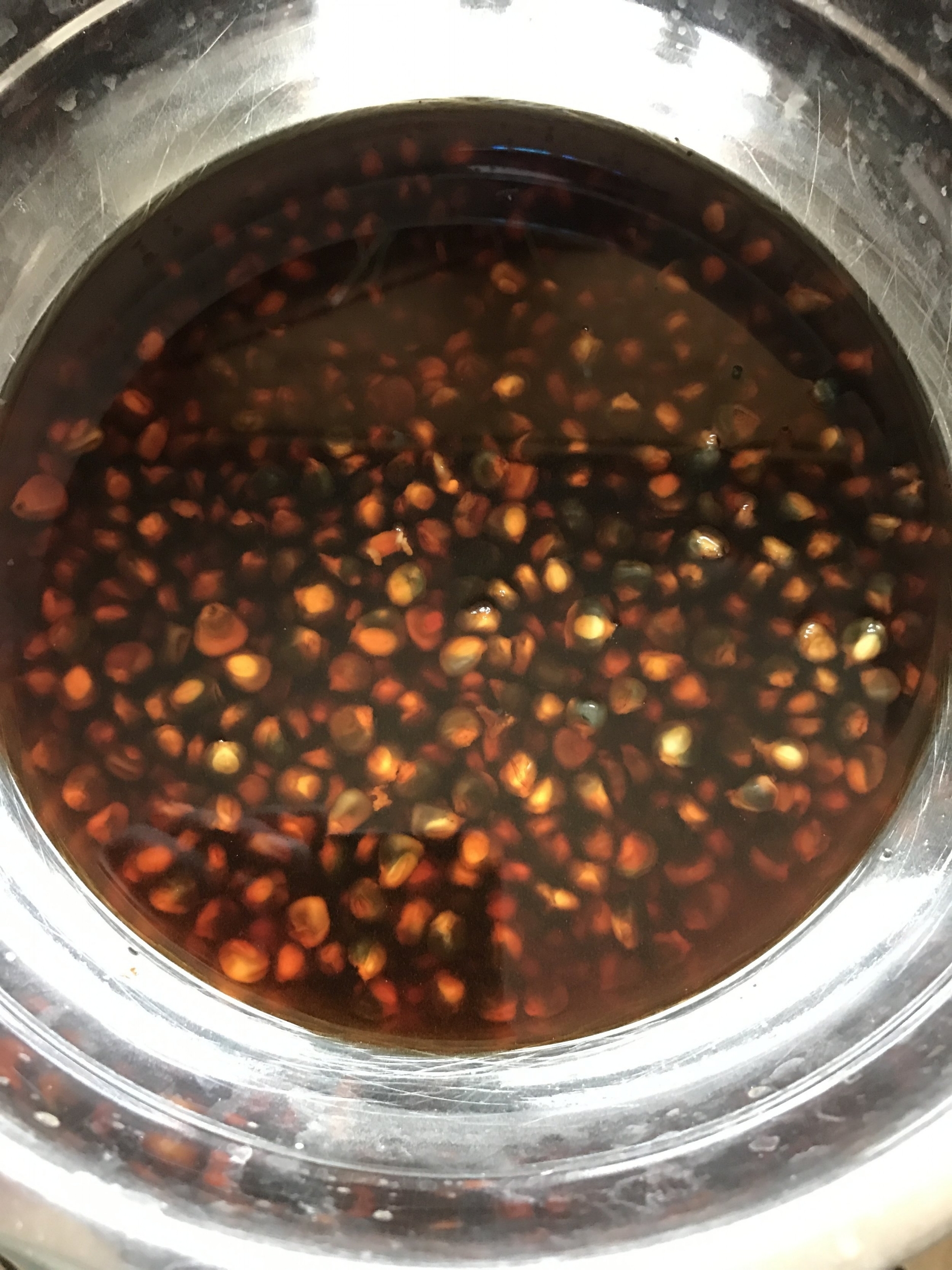
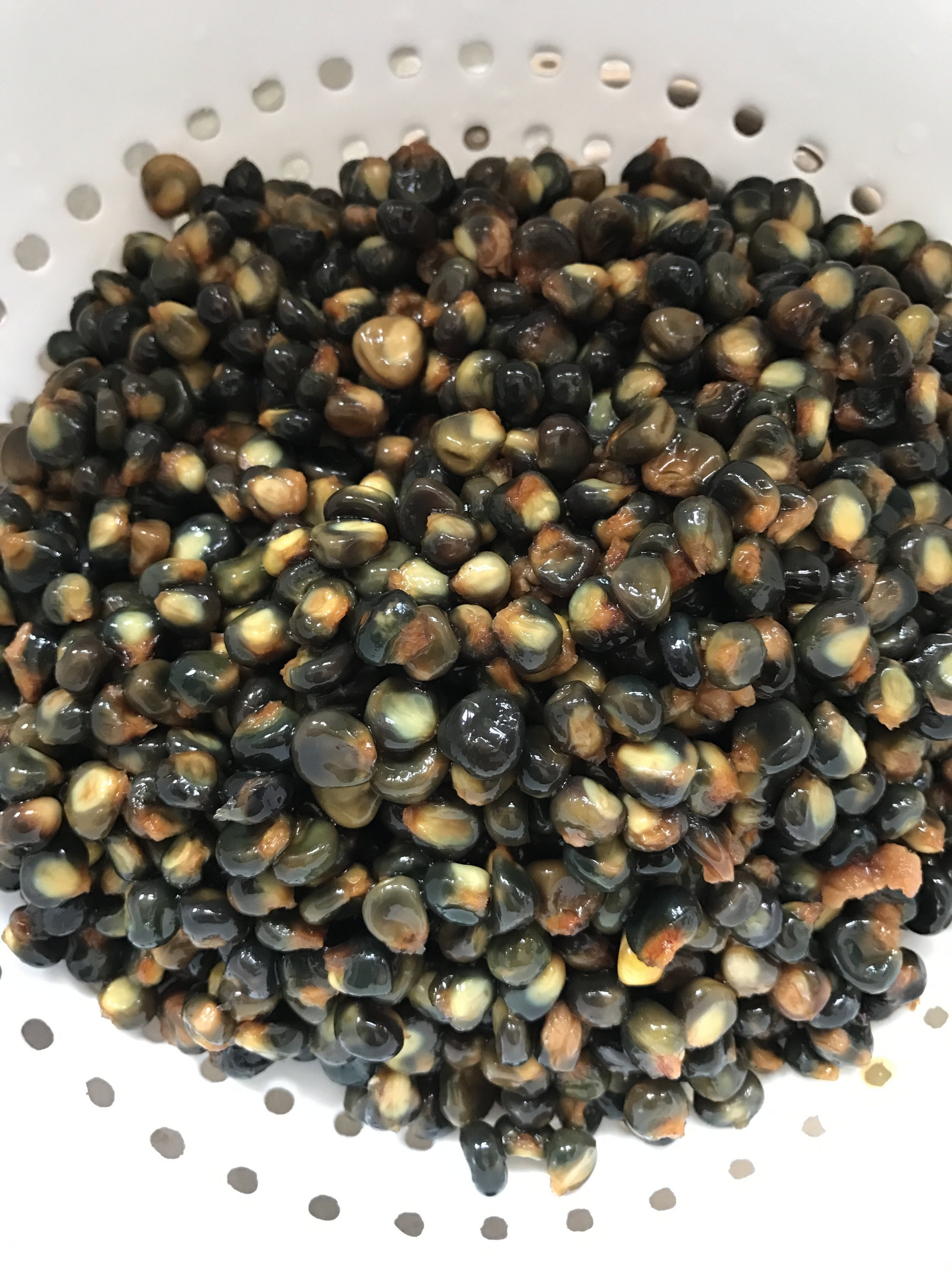

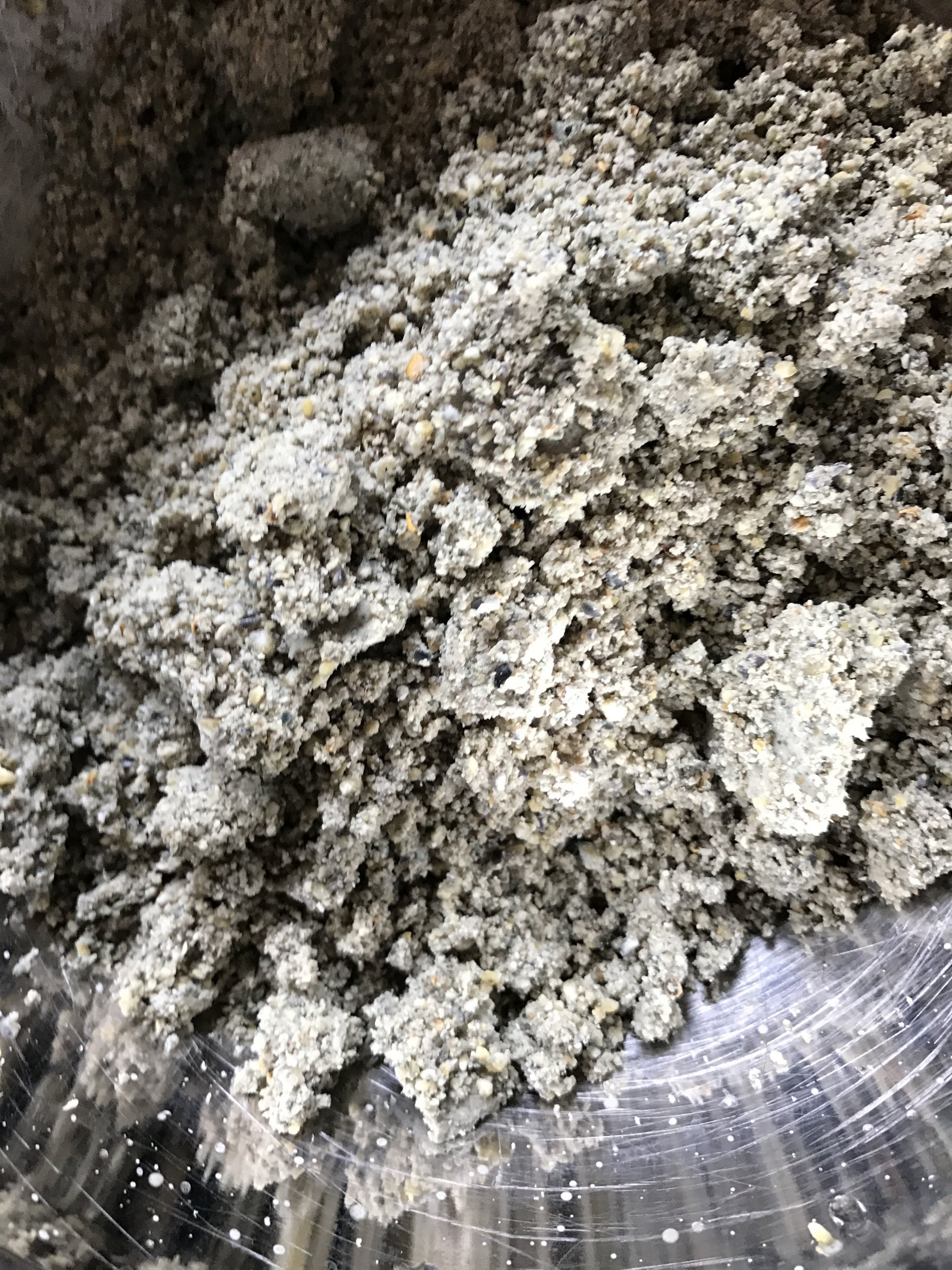
Directions:
Boil ashes in water for 10 minutes. Kill the heat and let settle for 30 minutes. Pour the lye water slowly off the top, leaving ashes on the bottom (eye protection and rubber gloves are a good idea). Add the corn to the lye water and simmer for 30 minutes. It will turn color in the first minute of boiling, telling you your solution is strong enough. Remove from heat and let stand, at room temperature, overnight. In the morning, drain and rinse the kernels, rubbing them between your hands to free the skins. Grind it. I go through the kitchen aide meat grinder's fine plate twice, then pulse in the food processor. Two rocks would work better. There you have it. Add splashes of water and knead to make dough for tortillas, or press on (tortilla joke, sorry) to make tamale dough...
How to make tamales:
Ingredients:
For the dough-
4 cups finely ground masa (yield from 2 cups dry corn)
1 tsp salt
1 tsp baking powder
2 Tbl lard
splash chicken stock
For the filling-
2 pounds meat (pork is traditional, any cut. Chicken legs used, in this case)
Lard for browning
6 chili pods
2 cups chicken stock
Corn husks
Salt
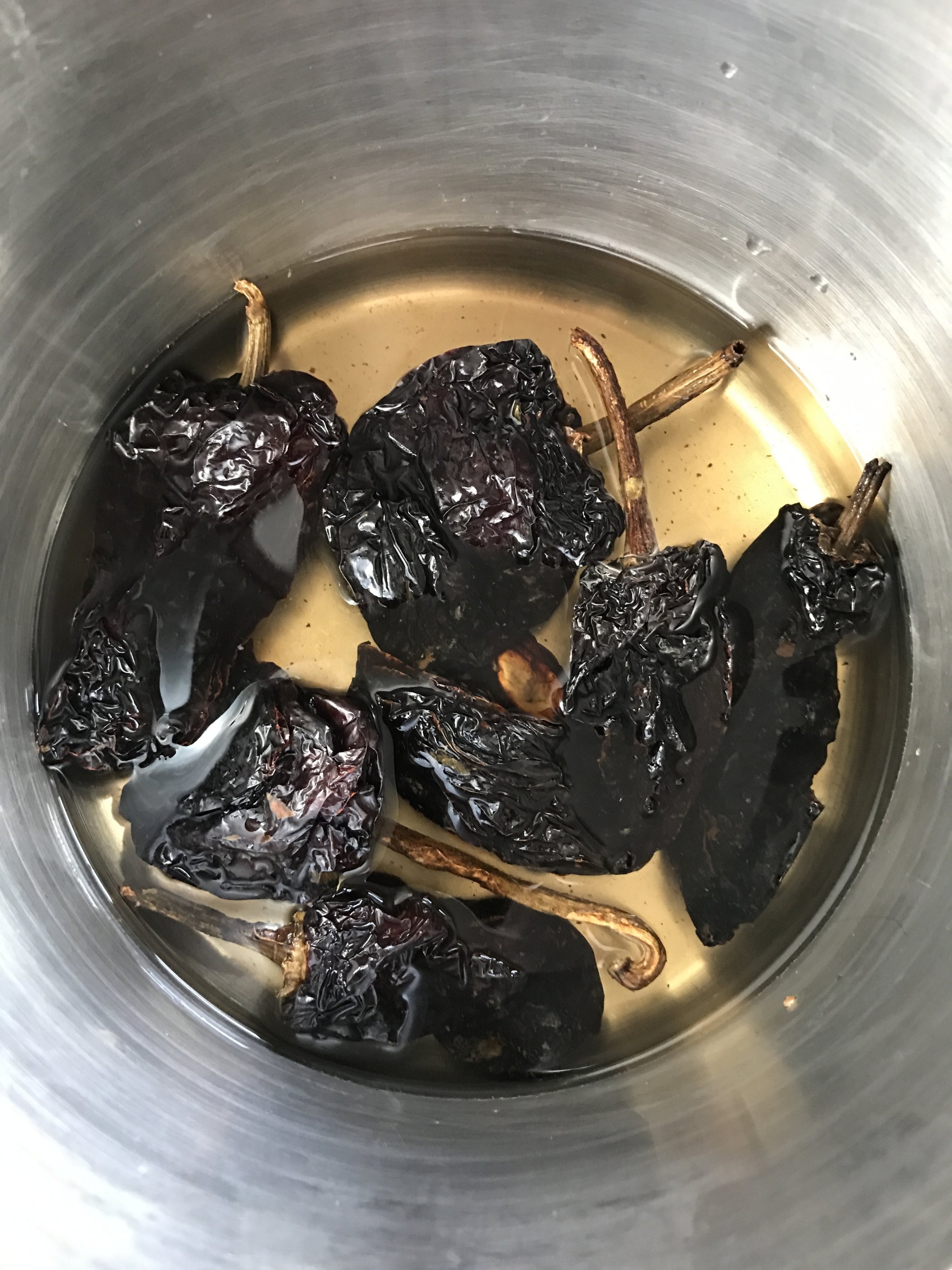
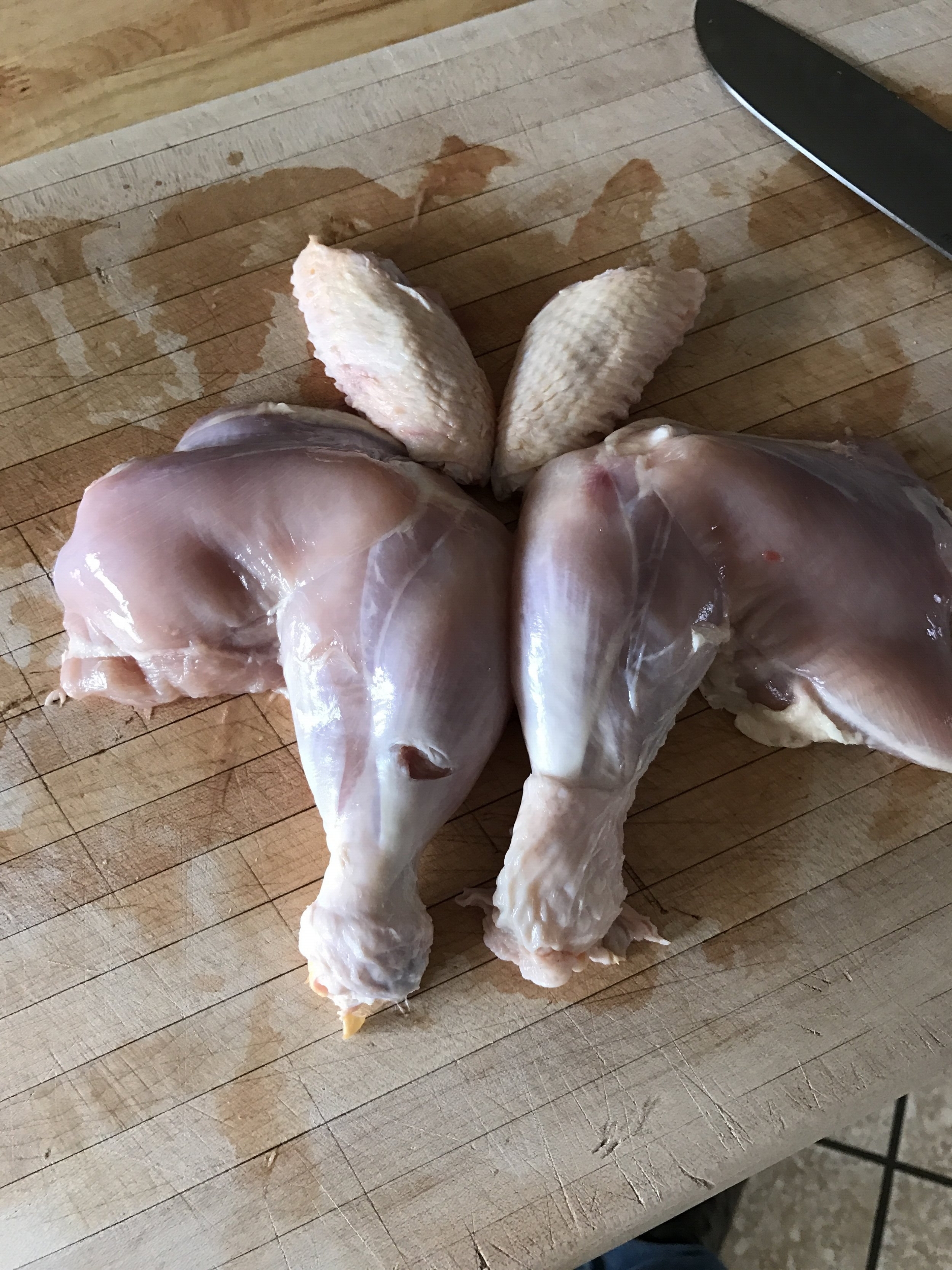
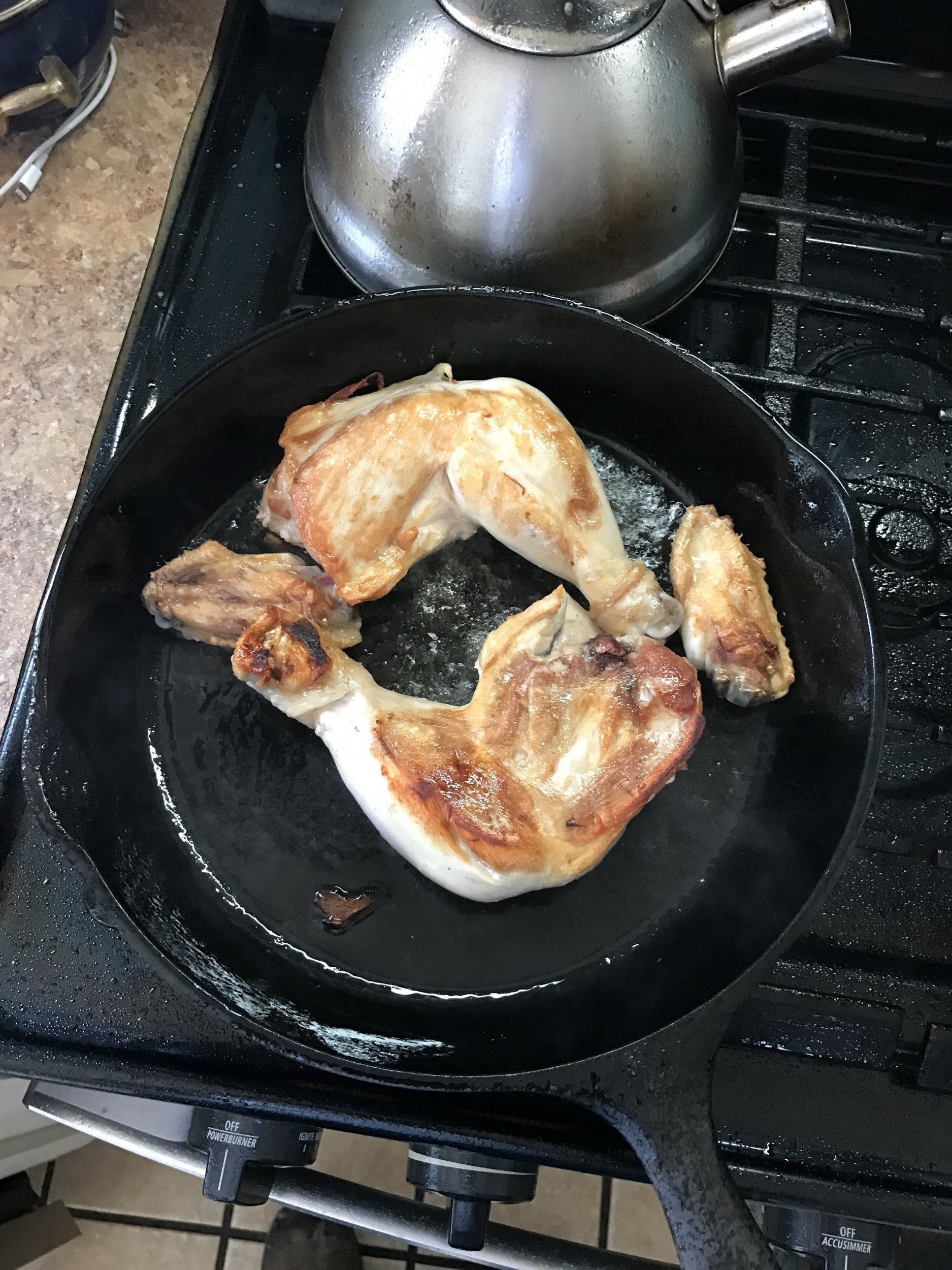
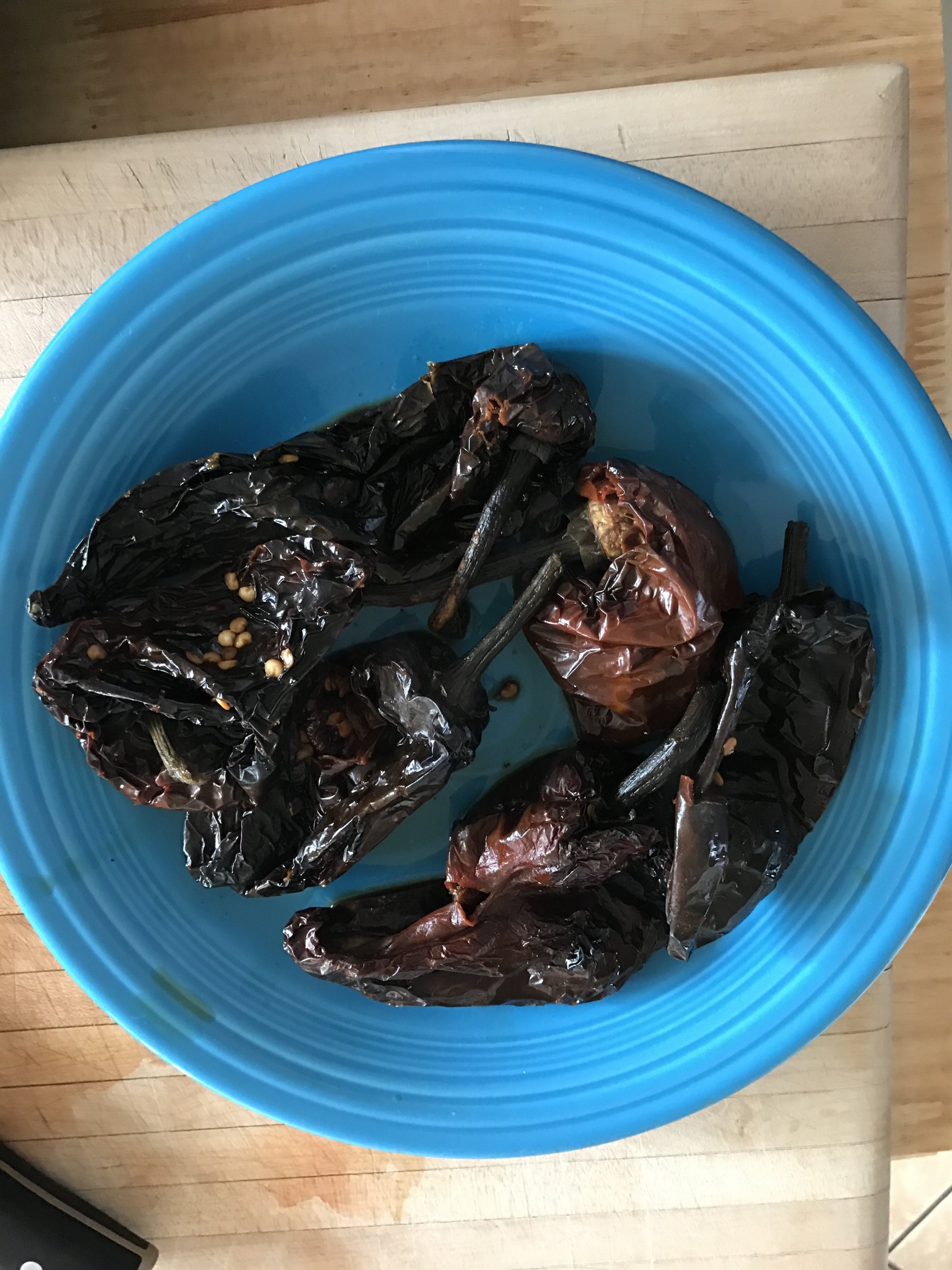
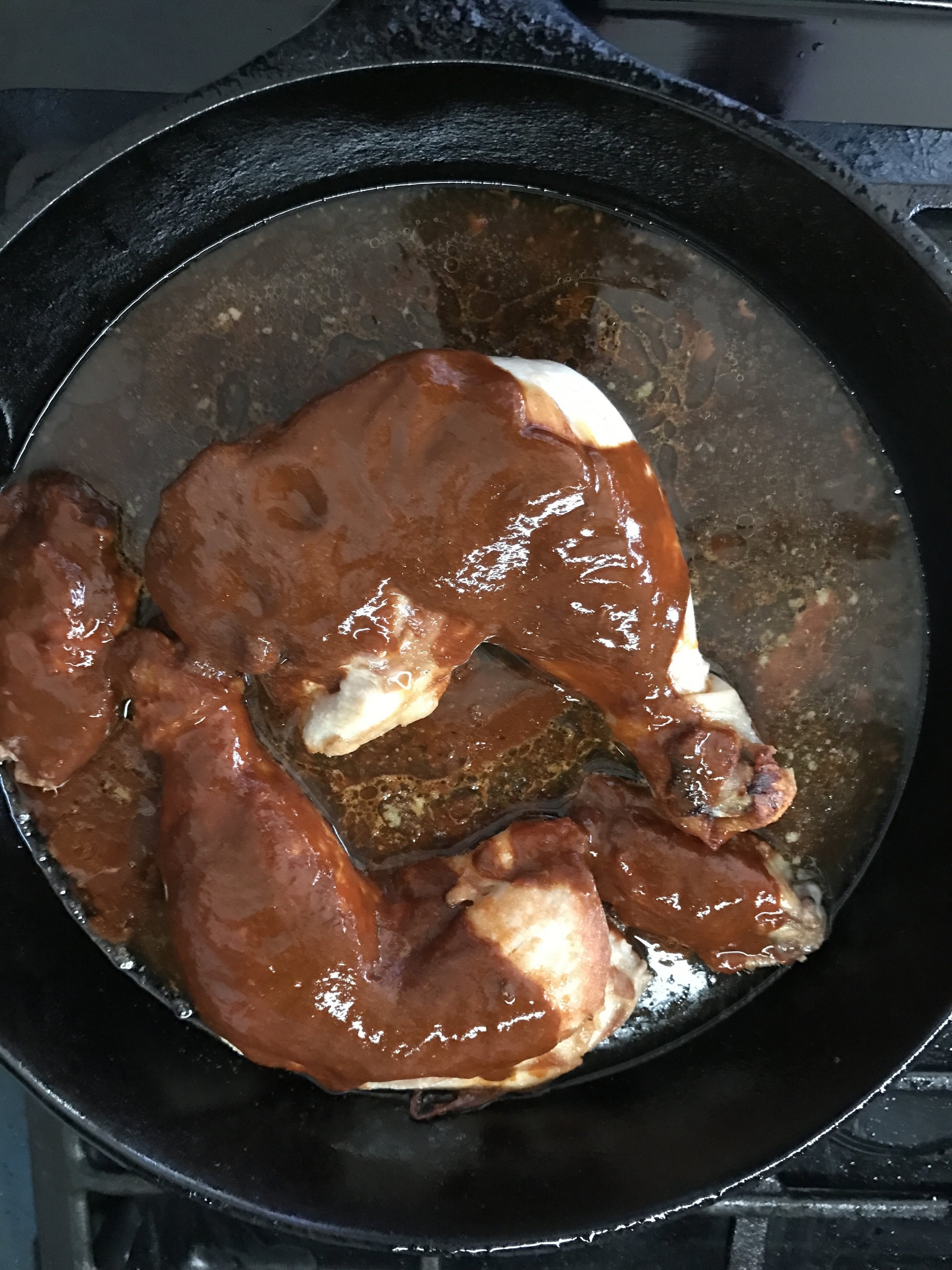
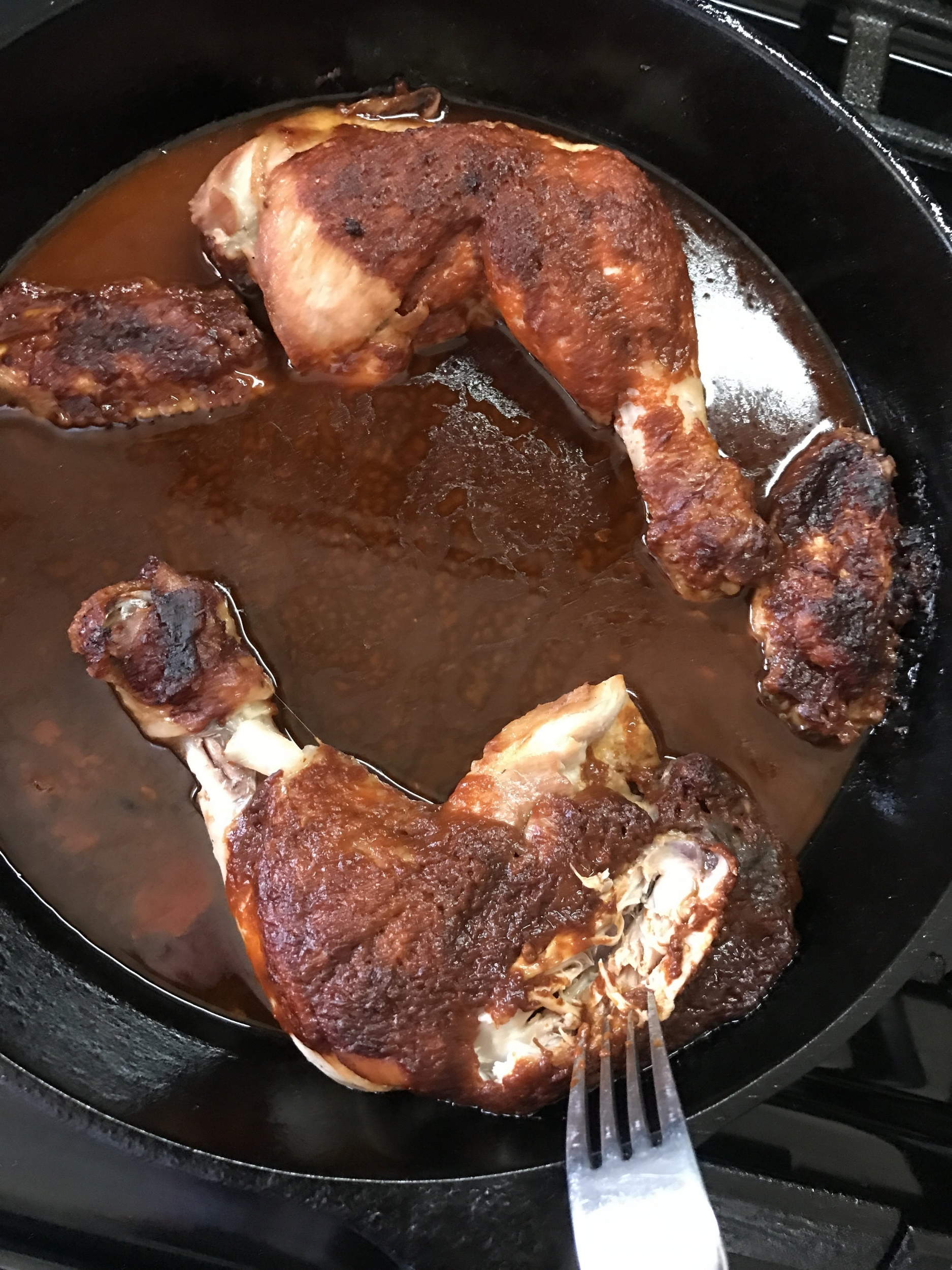
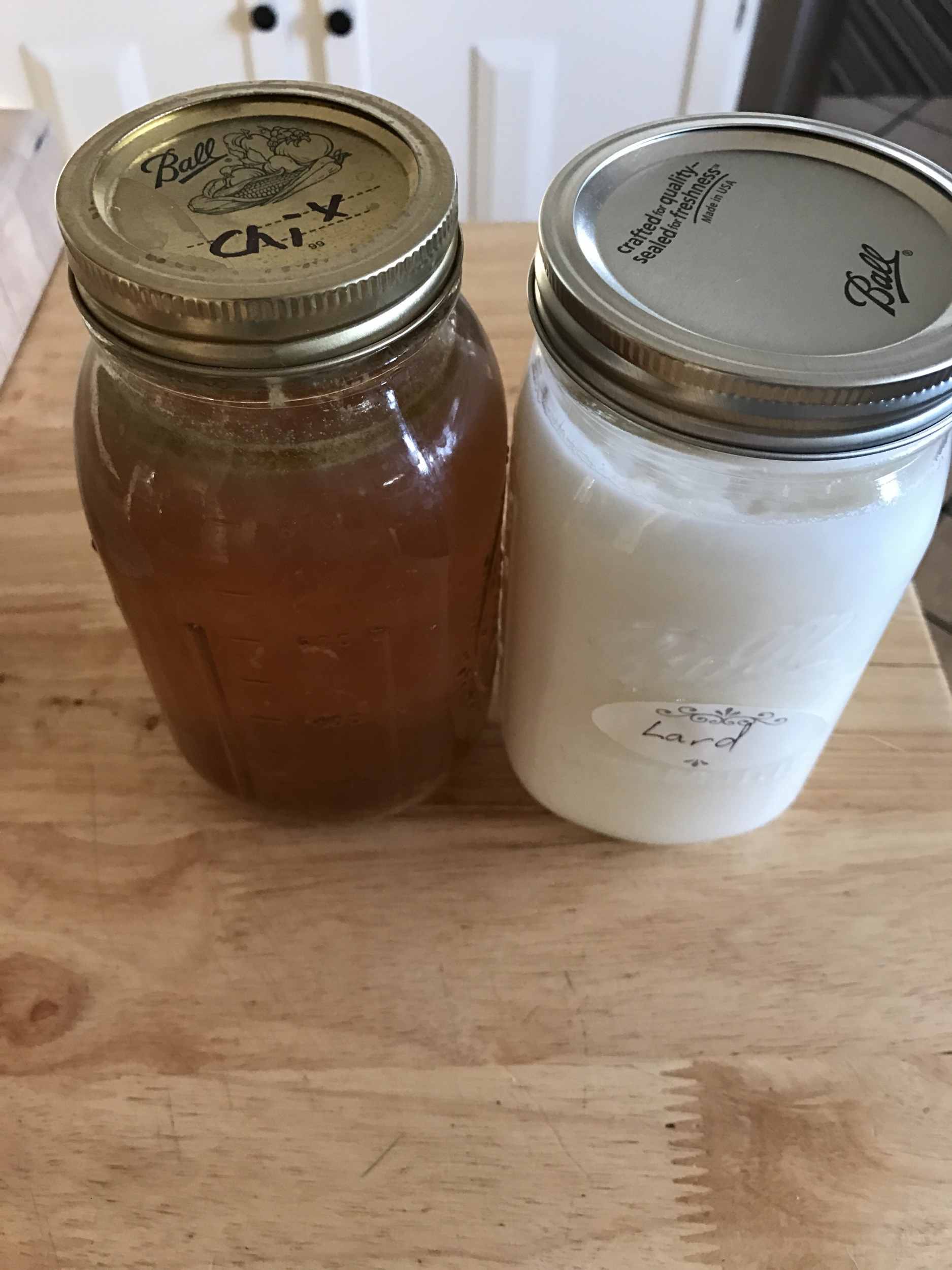
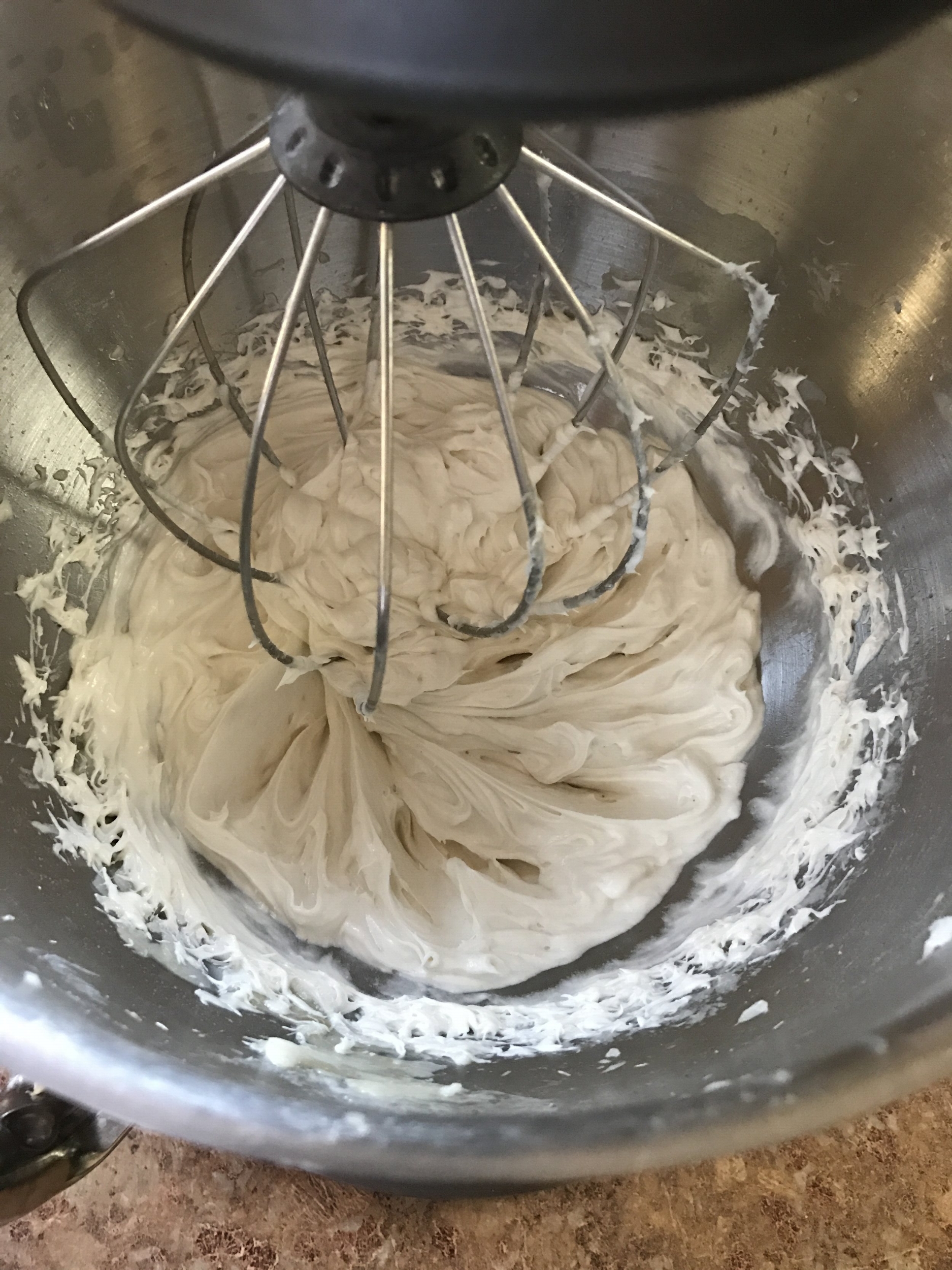

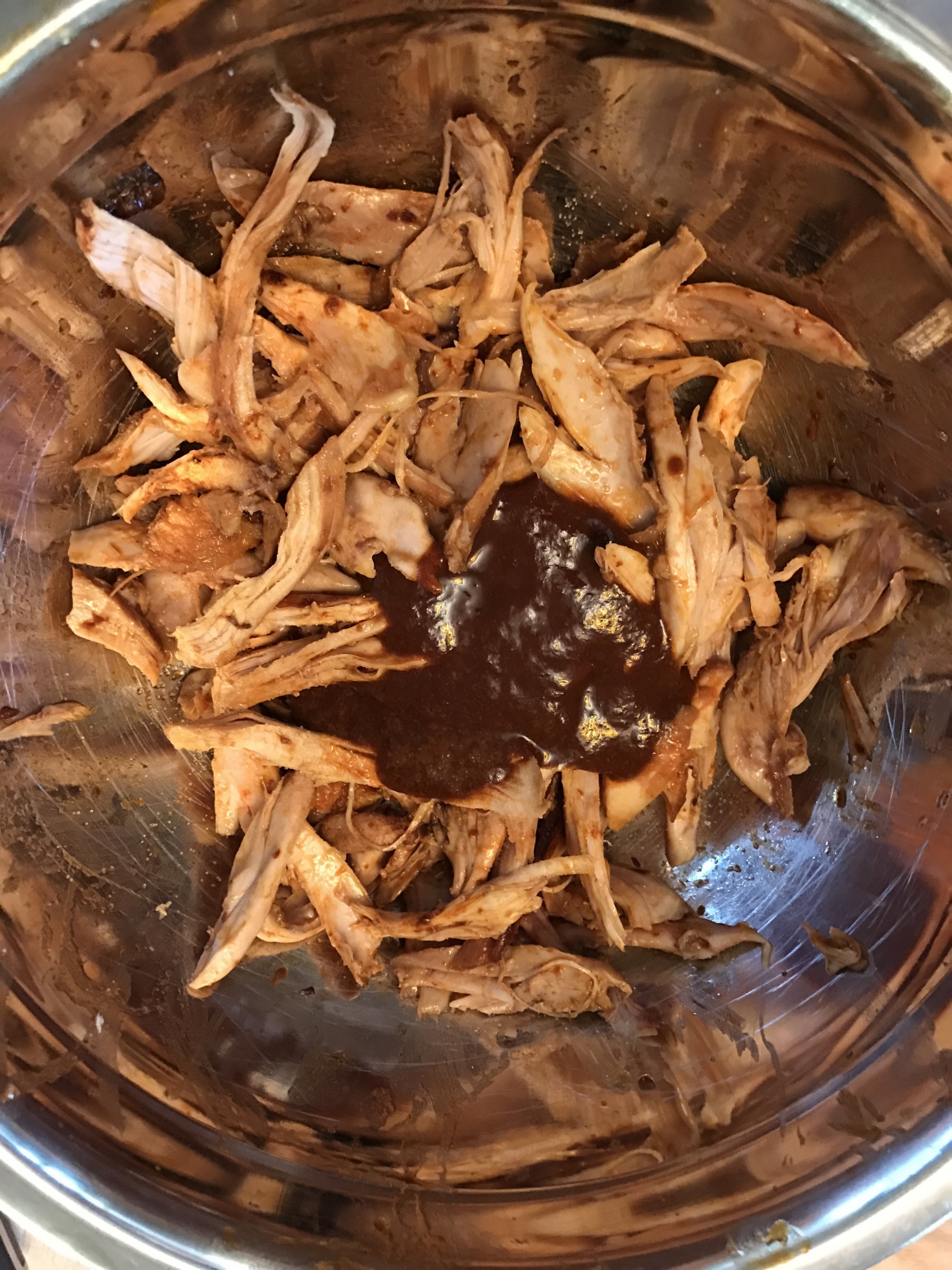
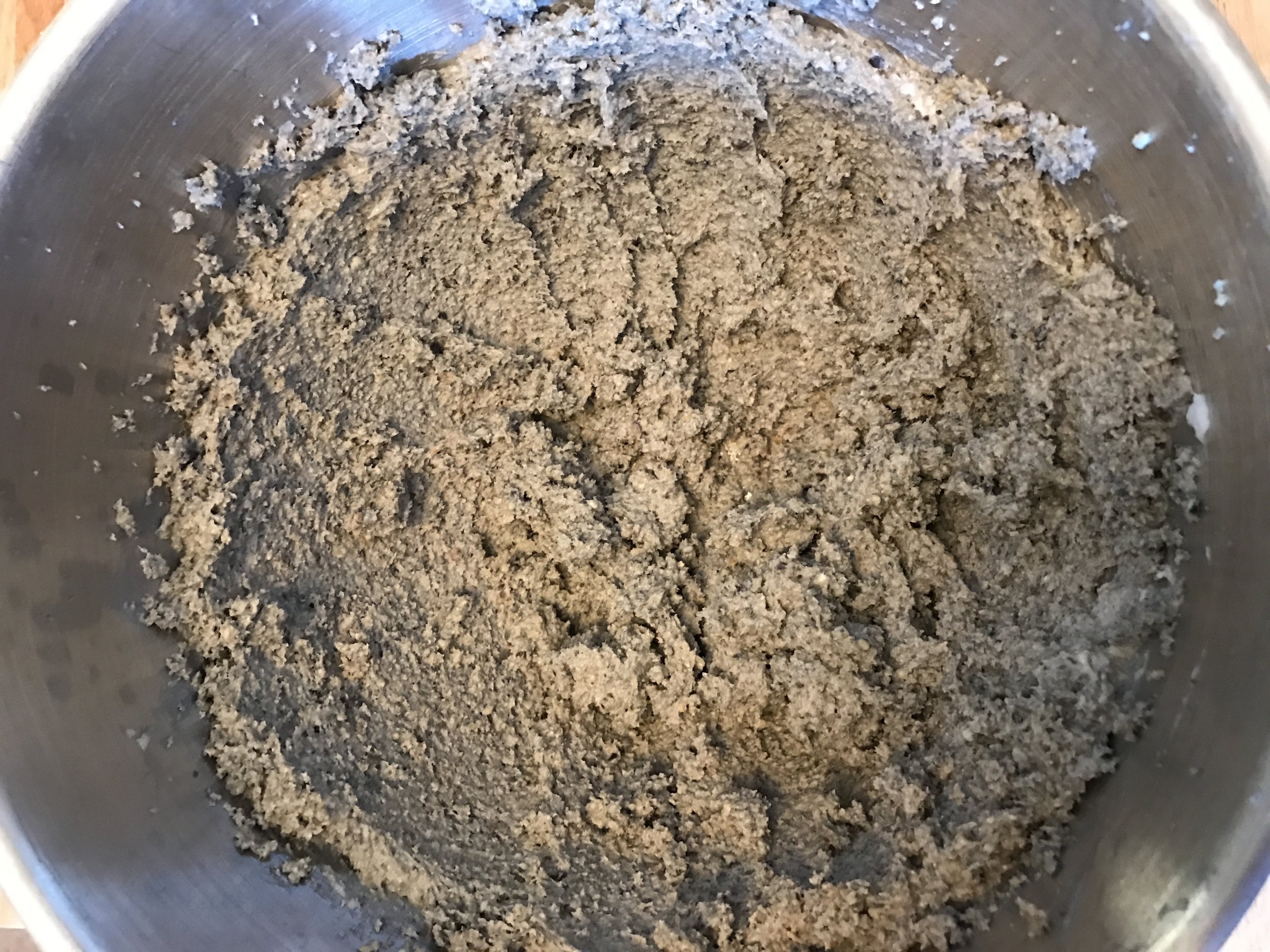
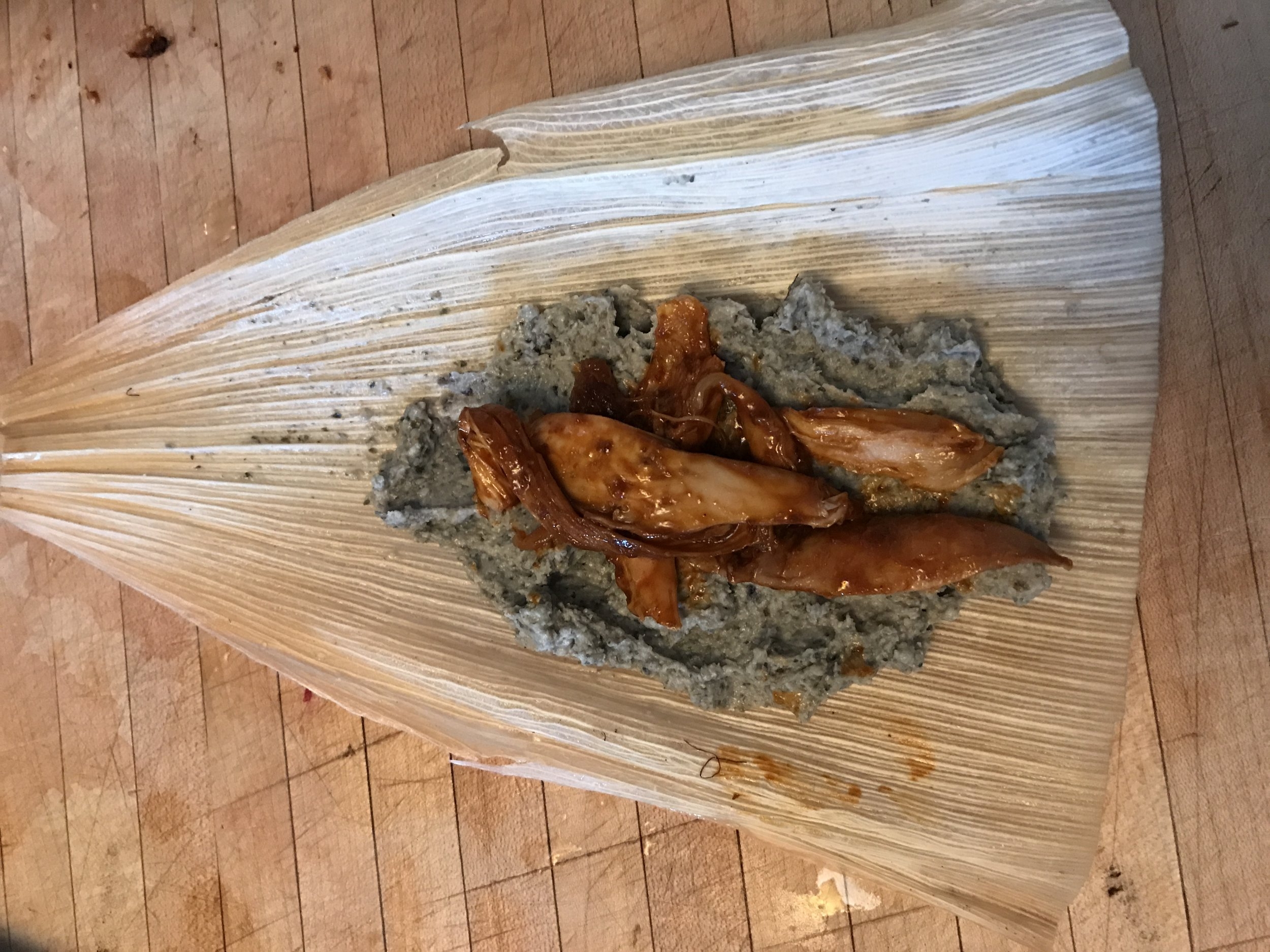
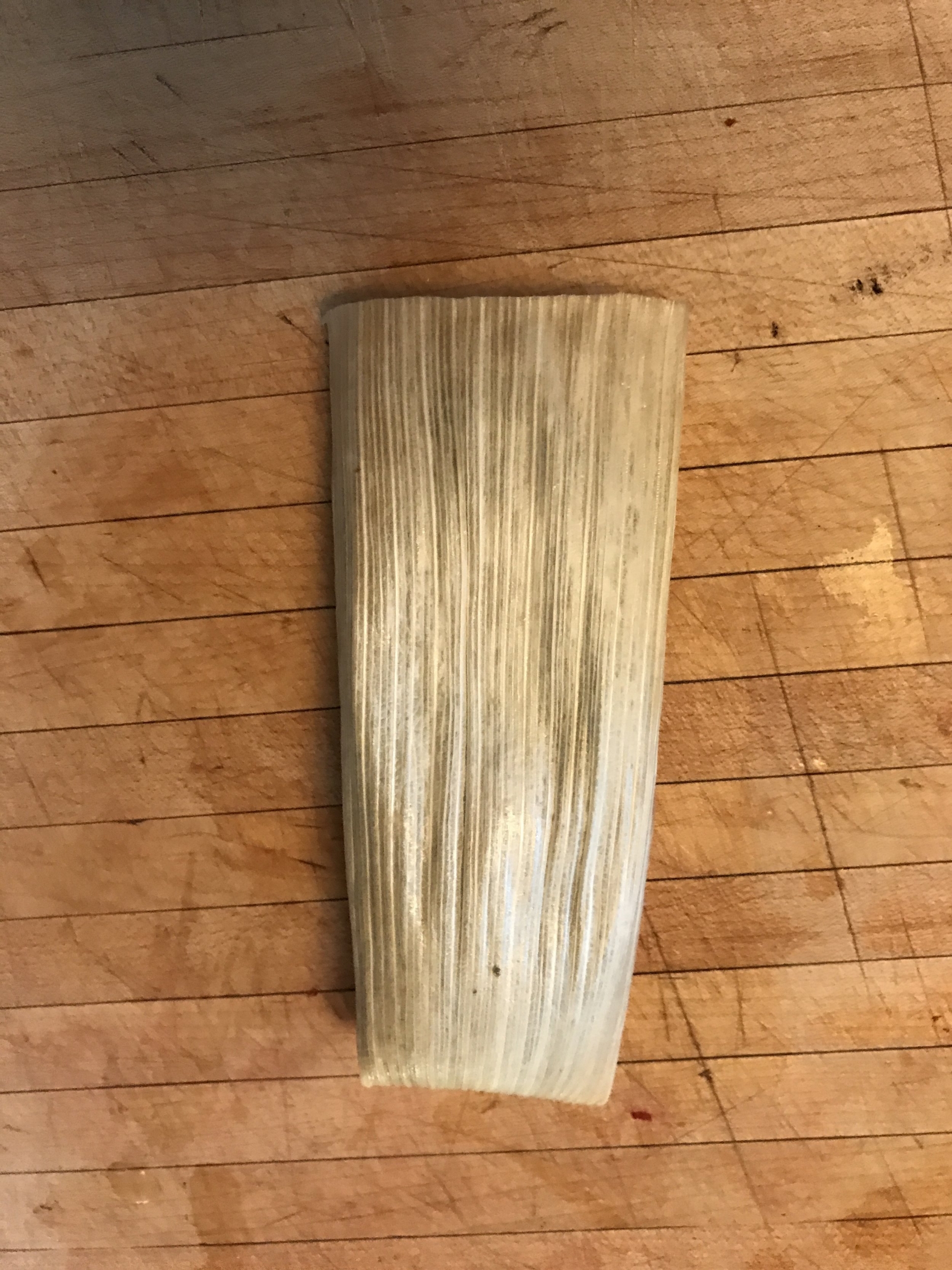
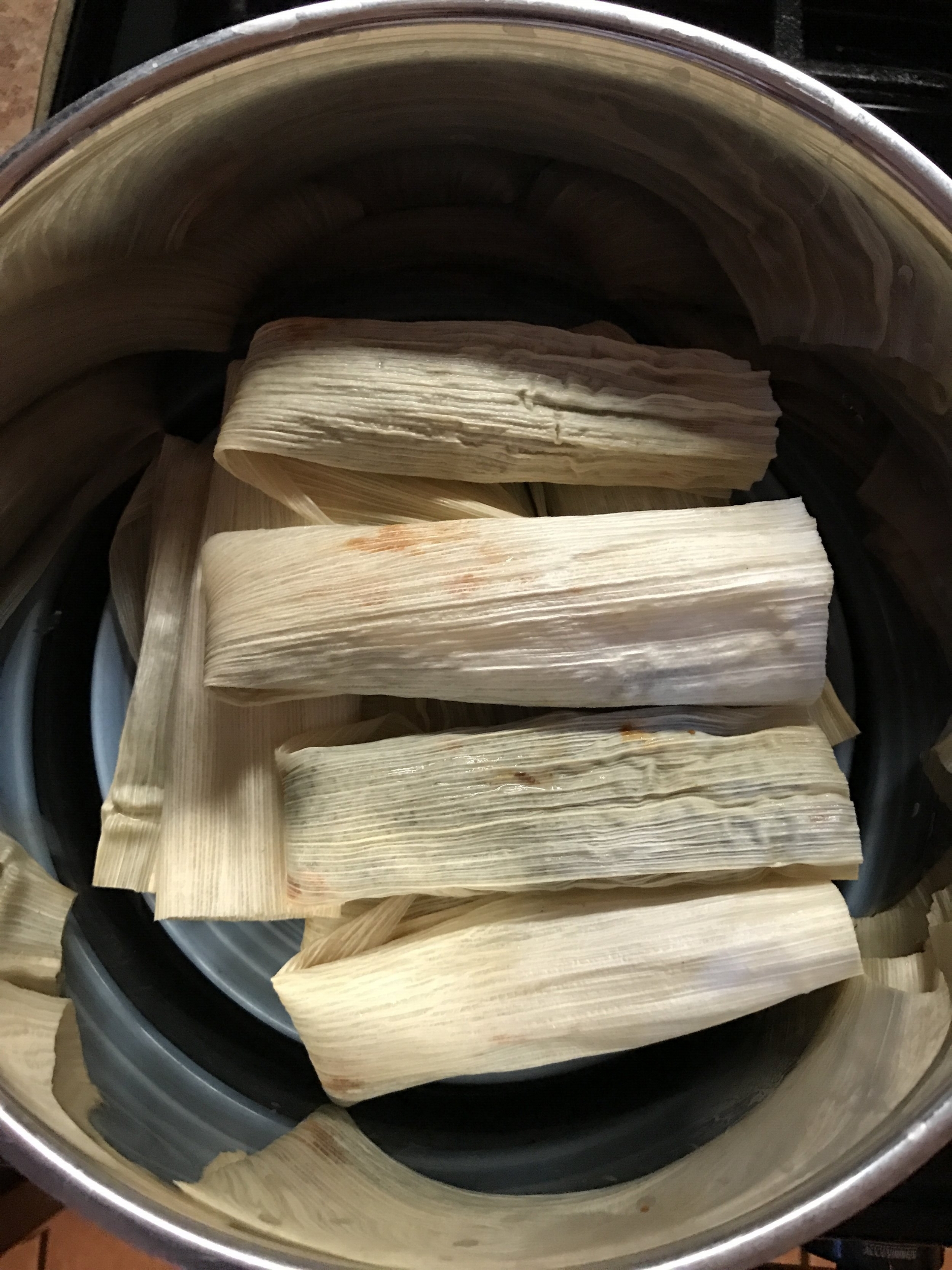
Directions:
Cover your dry chilis with just enough water to make them float. Use any kind you like. Chimayo are superb. I like these anchos (dried pablanos) for their dark color and sweet spice. sometimes I toss a couple chipotles in there, too. bring to a boil and simmer for 10 minutes. Remove this from the heat while you brown your meat in a tablespoon of lard. (I also rendered the fat out of the skin on these chicken legs, because yum). brow all sides of your meat well. Preheat the oven to 275F. Pull the chilis out of the water and allow to cool enough to handle, remove stems and seeds. Puree them with the strained water. This will make a chili paste. Spoon some of this (about 1/4) on the meat. Add 1 cup of the stock to the pan. Cover it and place it in the oven for 2-3 hours, or until it shreds easily with a fork. Put the 2 Tablespoons of lard, and a splash of stock, in a stand mixed and whip until fluffy. Mix the masa, the salt, and the baking powder and add it to the lard. Mix until combined, scraping the bowl to assure complete blending. Soak some dry corn husks in hot water, until pliable (*note: the only way to know that your corn husks are not glazed with round up is to grow your own... just saying). Mix shredded meat with another 1/4 of the chili paste. Add salt to taste. Place one corn husk on the counter and spread a heaping spoon of masa dough on it. Using tongs, center a pinch of meat on the dough. Roll and fold the husk and stack the tamale in a pot for steaming. A steaming basket, or a bowl in the bottom of the pot is helpful. Tamales must be out of the water. Repeat until all the stuff is used up. Add an inch or so of water to the pot, cover, and steam your tamales for an hour. Make sure you don't run out of water. A steamy simmer is all that is required. Heat your remaining chili paste in a small pot. Add stock to reach sauce consistency. Salt to taste. Unwrap the tamales you plan to serve, and smother them with chili sauce, and sour cream. Store the rest in their husks, in the fridge.
Once steamed, Tamales will last a week in the fridge, or months in the freezer. They reheat quickly in a pan with a splash of water, and a lid. To me, this is just about the highest form corn can achieve!
The products below are Amazon Affiliate links. If you buy through them, I receive a small commission with no added cost to you.




